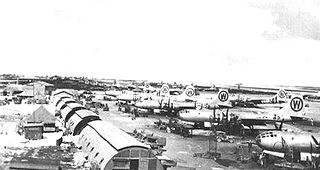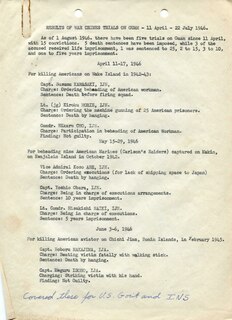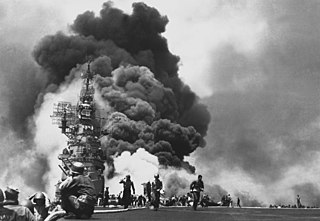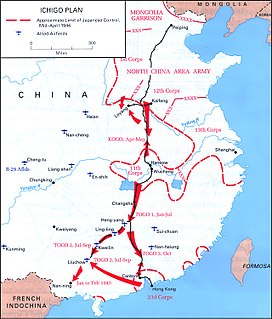 W
WOn 1 November 1944, a United States Army Air Forces (USAAF) F-13 Superfortress conducted the first flight by an Allied aircraft over the Tokyo region of Japan since the Doolittle Raid in April 1942. This photo reconnaissance sortie returned with 7000 photographs which helped with planning air raids on Japan during the last months of World War II. Attempts by Japanese air units and anti-aircraft gun batteries to shoot down the F-13 failed, as the available fighter aircraft and guns could not reach the high altitude at which it operated.
 W
WThe VII Fighter Command was a command and control organization of the United States Army Air Forces. Its last assignment was with Far East Air Forces. The Headquarters were based at several locations with Forward command moving with the campaigns. It was inactivated through being redesignated the 20th Fighter Wing and later, the 46th Fighter Wing on 24 August 1948.
 W
WThe 301st Fighter Wing is an Air Reserve Component (ARC) of the United States Air Force. It is assigned to the Tenth Air Force, Air Force Reserve Command, stationed at Carswell Field, Naval Air Station Joint Reserve Base Fort Worth, Texas. If mobilized, the Wing is gained by the Air Combat Command.
 W
WThe 505th Bombardment Group is an inactive United States Air Force unit. Its last assignment was with Thirteenth Air Force, stationed at Clark Field, Philippines. It was inactivated on 30 June 1946.
 W
WThe Battle of Angaur was a battle of the Pacific campaign in World War II, fought on the island of Angaur in the Palau Islands from 17 September—22 October 1944. This battle was part of a larger offensive campaign known as Operation Forager which ran from June 1944 to November 1944 in the Pacific Theater of Operations, and Operation Stalemate II in particular.
 W
WThe Battle of Changsha (1944) was an invasion of the Chinese province of Hunan by Japanese troops near the end of the Second Sino-Japanese War. As such, it encompasses three separate conflicts: an invasion of the city of Changsha and two invasions of Hengyang.
 W
WThe Battle of Mount Song, also known as the Battle of Ramou (拉孟の戦い), in 1944 was part of a larger campaign in southwest China during the Second World War. Chinese Nationalist forces aimed to retake the Burma Road.
 W
WThe Chichijima incident occurred in late 1944, when Japanese soldiers killed and consumed five American airmen on Chichi Jima, in the Bonin Islands.
 W
WThe Battle of Driniumor River, also known as the Battle of Aitape, 10 July – 25 August 1944, was part of the Western New Guinea campaign of World War II. During the fighting, Japanese forces launched several attacks on United States forces on the Driniumor River, near Aitape in New Guinea, over the course of several weeks with the intention of retaking Aitape. After making some initial gains, the Japanese attack was contained and eventually turned back having suffered heavy casualties. The battle should not be confused with Operation Persecution, which included amphibious landings near Aitape in April 1944, or the Aitape–Wewak campaign, which began in November that year.
 W
WThe Formosa Air Battle, 12–16 October 1944, was a series of large-scale aerial engagements between carrier air groups of the United States Navy Fast Carrier Task Force, and Japanese land-based air forces of the Imperial Japanese Navy (IJN) and Imperial Japanese Army (IJA).
 W
WThe Japan campaign was a series of battles and engagements in and around the Japanese home islands, between Allied forces and the forces of Imperial Japan during the last stages of the Pacific campaign of World War II. The Japan campaign lasted from around June 1944 to August 1945.
 W
WKamikaze , officially Kamikaze/Shinpū Tokubetsu Kōgekitai , were a part of the Japanese Special Attack Units of military aviators who flew suicide attacks for the Empire of Japan against Allied naval vessels in the closing stages of the Pacific campaign of World War II, intending to destroy warships more effectively than with conventional air attacks. About 3,800 kamikaze pilots died during the war, and more than 7,000 naval personnel were killed by kamikaze attacks.
 W
WOperation Ichi-Go was a campaign of a series of major battles between the Imperial Japanese Army forces and the National Revolutionary Army of the Republic of China, fought from April to December 1944. It consisted of three separate battles in the Chinese provinces of Henan, Hunan and Guangxi.
 W
WOperation Matterhorn was a military operation of the United States Army Air Forces in World War II for the strategic bombing of Japanese forces by B-29 Superfortresses based in India and China. Targets included Japan itself, and Japanese bases in China and South East Asia. The name comes from the Matterhorn, a mountain traditionally considered particularly difficult to climb.
 W
WThe Palawan massacre occurred on 14 December 1944, during World War II, near the city of Puerto Princesa in the Philippine province of Palawan. Allied soldiers, imprisoned near the city, were killed by Imperial Japanese soldiers.
 W
WThe Battle of the Philippine Sea was a major naval battle of World War II that eliminated the Imperial Japanese Navy's ability to conduct large-scale carrier actions. It took place during the United States' amphibious invasion of the Mariana Islands during the Pacific War. The battle was the last of five major "carrier-versus-carrier" engagements between American and Japanese naval forces, and pitted elements of the United States Navy's Fifth Fleet against ships and aircraft of the Imperial Japanese Navy's Mobile Fleet and nearby island garrisons. This was the largest carrier-to-carrier battle in history, involving 24 aircraft carriers, deploying roughly 1,350 carrier-based aircraft.
 W
WThe 1944 Tōnankai earthquake occurred at 13:35 local time on 7 December. It had an estimated magnitude of 8.1 on the moment magnitude scale and a maximum felt intensity of greater than 5 shindo. It triggered a large tsunami that caused serious damage along the coast of Wakayama Prefecture and the Tōkai region. Together the earthquake and tsunami caused 3,358 casualties.
 W
WThe U Go offensive, or Operation C, was the Japanese offensive launched in March 1944 against forces of the British Empire in the northeast Indian regions of Manipur and the Naga Hills. Aimed at the Brahmaputra valley, through the two towns of Imphal and Kohima, the offensive along with the overlapping Ha Go offensive was one of the last major Japanese offensives during the Second World War. The offensive culminated in the Battles of Imphal and Kohima, where the Japanese and their allies were first held and then pushed back.
 W
WThe Bombing of Yawata on the night of 15/16 June 1944 was the first air raid on the Japanese home islands conducted by United States Army Air Forces (USAAF) strategic bombers during World War II. The raid was undertaken by 75 B-29 Superfortress heavy bombers staging from bases in China. Only 47 of these aircraft bombed the raid's primary target, the Imperial Iron and Steel Works at Yawata in northern Kyūshū, and little damage was caused. Five B-29s were lost in accidents during the operation and two were destroyed by Japanese aircraft.